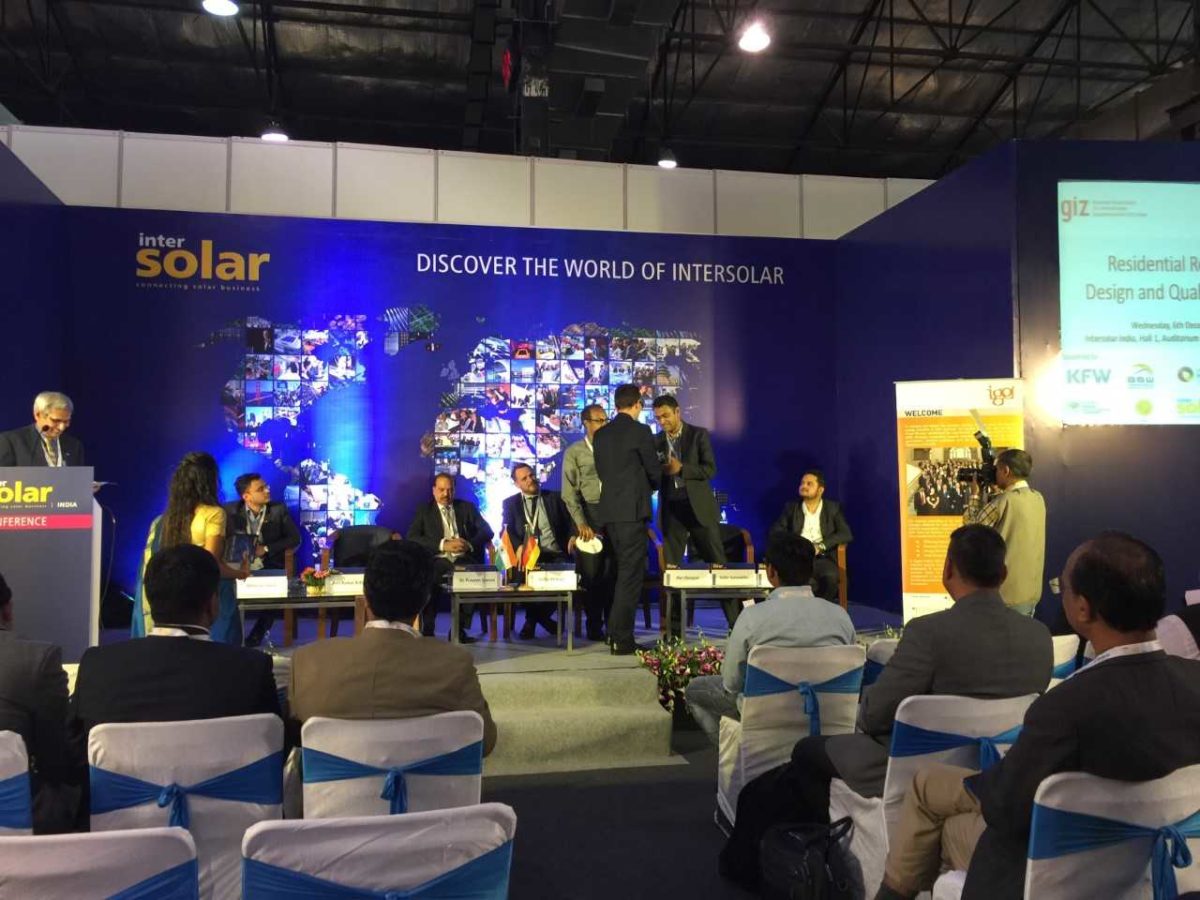The event in question was titled “Residential Rooftop Systems – Design and Quality Go Hand in Hand” and was organized by the German GIZ and IGEF, the Indo-German Energy Forum.
Both organizers took advantage of the platform provided by Intersolar India, which brought together an estimated 12,000 participants in a two day conference and a three day exhibition.
The Indian government has been a staunch supporter of renewable energy and solar PV, but progress on the residential PV front has been limited. As of the end of March 2017, cumulative residential PV installations amounted to only 1.4 GW, a far cry from the 10 GW target the government has established for 2020.
To identify the obstacles and find solutions GIZ and IGEF brought together a range of experts in residential PV at this workshop, held on December 6.
K.R. Harinarayan, who runs U-Solar Clean Energy Solutions Pvt. Ltd., a PV installation company based in Bangalore, highlighted the fact that the power market in India is essentially regulated by the Indian states, and that each state has taken a different approach to PV policies and standards in the residential rooftop market. According to Harinarayan, “this represents a huge hurdle for rolling out solar” in India.
This contrasts with the experience in Germany, where a national PV feed-in tariff launched in 2000 propelled the residential sector to become the bastion of the country’s solar market. On the other hand, the U.S. residential market has thrived, where it is the 50 states, and not the federal government, that are the main drivers of PV adoption.
For India watchers it will not come as a surprise that bureaucratic hurdles are another obstacle for residential PV adoption. Harinarayan described the current situation in Karnataka, where net metering applications can take four months to be processed and involve 15 separate steps.
Net metering serves as the main driver of residential PV adoption in India, but a four month processing time stands in sharp contrast to the one week U-Solar typically needs to install a residential rooftop system.
Another veteran of the budding Indian residential market, Sishir Garemella, founder and CEO of Mumbai-based Sunvest Energy Private Limited, who presented on the Indian residential market at Intersolar India 2011, cautioned this year’s workshop participants to factor in the unique conditions of residential PV in India.
Standardized software tools should be used, he said, to plan systems and calculate outputs fails to take into account environmental challenges, which in Mumbai, for example, can range from abundant bird droppings to the severe cyclone that hit the city on the first day of this year’s Intersolar.
Popular content
These environmental challenges start before the system is even installed. Garemella has seen cases where modules are transported to installation sites by bicycle and this mode of transportation – coupled with poor street conditions – can lead to cracks in the modules already during transport. To address this risk, Garemella strongly recommends securing transit insurance.
An even more serious challenge to residential PV adoption is the fact that in India, according to Garemella, “no two roofs look the same.” This does not provide for a cookie-cutting planning and installation process, like those leading residential solar players have adopted to roll out rooftop solar in the U.S.
GIZ hopes to make this possible in India with its plug-and-play residential solar kit, specifically designed for the Indian market.
In his presentation Sandeep Goel, Technical Expert, GIZ India, described the new “PV Port & Store” solution, which GIZ plans to roll out in cooperation with India’s Discoms in 2018.
The PV Port & Store solution is purely aimed at self-consumption and can easily be plugged into a home’s electricity network using a 15 Amp socket. By incorporating a battery, the system allows for PV power usage even when the sun is not shining, thereby boosting the user’s independence from the grid.
For Discoms the real benefit comes with mass adoption (for example, 50,000 kits installed), since this amount of distributed energy resources could serve to stabilize the distribution grid, allowing for peak shaving and other grid benefits.
Given these benefits for both consumers and India’s regional Discoms, GIZ’s goal of supplying 50% of the government’s 10 GW target with this kit seems achievable, especially since GIZ is also adding attractive financing options to the mix.
The GIZ approach would avoid the multi-step process slowing down net metering in India and most importantly, their approach is to work closely with Discoms, a critical piece of the puzzle in unlocking residential PV in this very large market.
This content is protected by copyright and may not be reused. If you want to cooperate with us and would like to reuse some of our content, please contact: editors@pv-magazine.com.


By submitting this form you agree to pv magazine using your data for the purposes of publishing your comment.
Your personal data will only be disclosed or otherwise transmitted to third parties for the purposes of spam filtering or if this is necessary for technical maintenance of the website. Any other transfer to third parties will not take place unless this is justified on the basis of applicable data protection regulations or if pv magazine is legally obliged to do so.
You may revoke this consent at any time with effect for the future, in which case your personal data will be deleted immediately. Otherwise, your data will be deleted if pv magazine has processed your request or the purpose of data storage is fulfilled.
Further information on data privacy can be found in our Data Protection Policy.